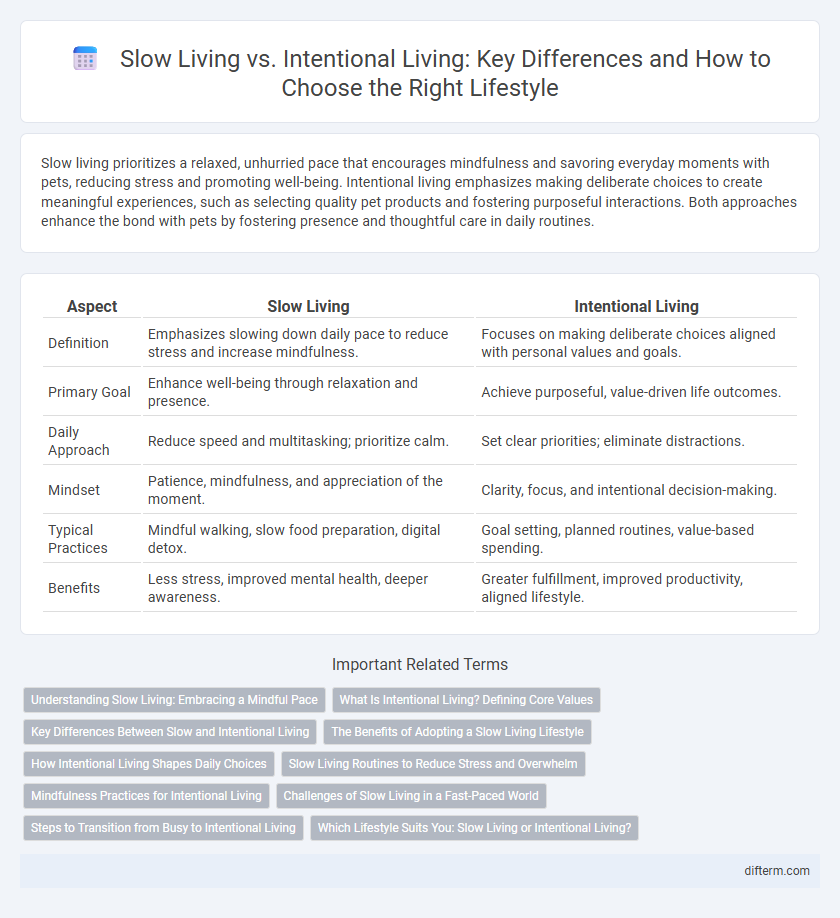Slow living prioritizes a relaxed, unhurried pace that encourages mindfulness and savoring everyday moments with pets, reducing stress and promoting well-being. Intentional living emphasizes making deliberate choices to create meaningful experiences, such as selecting quality pet products and fostering purposeful interactions. Both approaches enhance the bond with pets by fostering presence and thoughtful care in daily routines.
Table of Comparison
| Aspect | Slow Living | Intentional Living |
|---|---|---|
| Definition | Emphasizes slowing down daily pace to reduce stress and increase mindfulness. | Focuses on making deliberate choices aligned with personal values and goals. |
| Primary Goal | Enhance well-being through relaxation and presence. | Achieve purposeful, value-driven life outcomes. |
| Daily Approach | Reduce speed and multitasking; prioritize calm. | Set clear priorities; eliminate distractions. |
| Mindset | Patience, mindfulness, and appreciation of the moment. | Clarity, focus, and intentional decision-making. |
| Typical Practices | Mindful walking, slow food preparation, digital detox. | Goal setting, planned routines, value-based spending. |
| Benefits | Less stress, improved mental health, deeper awareness. | Greater fulfillment, improved productivity, aligned lifestyle. |
Understanding Slow Living: Embracing a Mindful Pace
Slow living emphasizes a mindful pace by encouraging individuals to savor each moment, reduce stress, and prioritize quality over quantity in daily activities. This lifestyle promotes deeper connections with oneself and the environment through practices like mindful eating, slow travel, and intentional breaks. Embracing slow living cultivates presence and balance, counteracting the fast-paced demands of modern life.
What Is Intentional Living? Defining Core Values
Intentional living centers on making conscious choices aligned with core values, fostering a purposeful lifestyle that prioritizes meaningful experiences over mindless consumption. Defining core values such as authenticity, gratitude, and mindfulness guides decision-making and shapes daily habits. This approach cultivates clarity, reduces distractions, and enhances overall well-being by encouraging focus on what truly matters.
Key Differences Between Slow and Intentional Living
Slow living emphasizes reducing pace and simplifying routines to minimize stress and increase mindfulness, while intentional living centers on making deliberate choices aligned with core values and long-term goals. Slow living often involves embracing minimalism and disconnecting from fast-paced environments, whereas intentional living prioritizes purposeful actions and consistent reflection on personal growth. Both approaches promote well-being but differ in focus: slow living targets lifestyle tempo, and intentional living targets conscious decision-making.
The Benefits of Adopting a Slow Living Lifestyle
Adopting a slow living lifestyle enhances mental well-being by reducing stress through mindful pacing and deeper engagement with daily activities. This approach fosters stronger relationships and a heightened appreciation for moments often overlooked in fast-paced environments. Embracing slow living promotes sustainability by encouraging conscious consumption and a focus on quality over quantity.
How Intentional Living Shapes Daily Choices
Intentional living shapes daily choices by encouraging mindfulness and prioritization of values, leading to purposeful actions that align with long-term goals. Unlike slow living's emphasis on deceleration and simplicity, intentional living focuses on deliberate decision-making that cultivates personal growth and well-being. This approach enhances clarity and reduces distractions, fostering a life driven by conscious intent rather than habitual routines.
Slow Living Routines to Reduce Stress and Overwhelm
Slow living routines emphasize mindful pacing through activities like deep breathing, mindful walks, and simplified daily tasks to effectively reduce stress and overwhelm. Incorporating consistent practices such as digital detoxes, mindful meal preparation, and dedicated relaxation time nurtures mental clarity and emotional balance. These habits promote a calm, present-focused lifestyle that counters the frantic pace of modern life.
Mindfulness Practices for Intentional Living
Mindfulness practices for intentional living emphasize present-moment awareness and purposeful actions to enhance well-being and reduce stress. Techniques such as meditation, mindful breathing, and conscious decision-making cultivate clarity and focus, enabling individuals to align daily choices with personal values. This approach contrasts with slow living by prioritizing deliberate mental engagement over simply decelerating life's pace.
Challenges of Slow Living in a Fast-Paced World
Slow living faces significant challenges in a fast-paced world characterized by constant connectivity and urgent demands. The pressure to multitask and meet deadlines often undermines the core principles of mindfulness and presence that slow living promotes. Balancing economic necessities with a desire for deliberate pacing requires intentional boundaries and disciplined practice.
Steps to Transition from Busy to Intentional Living
Transitioning from busy to intentional living involves prioritizing daily activities that align with core values and long-term goals, reducing unnecessary commitments to create space for mindfulness and reflection. Incorporating regular practices such as journaling, meditation, and setting clear boundaries around work and personal time helps foster deeper presence and purposeful engagement in each moment. Embracing gradual lifestyle shifts, like simplifying possessions and focusing on meaningful relationships, supports sustainable intentional habits that enhance overall well-being.
Which Lifestyle Suits You: Slow Living or Intentional Living?
Slow Living emphasizes reducing pace and embracing simplicity to enhance mindfulness and reduce stress, ideal for those seeking balance and calm. Intentional Living involves making purposeful choices aligned with personal values and goals, perfect for individuals driven by clarity and focused growth. Assess your priorities and daily habits to determine which lifestyle resonates with your need for tranquility or deliberate action.
Slow Living vs Intentional Living Infographic

 difterm.com
difterm.com